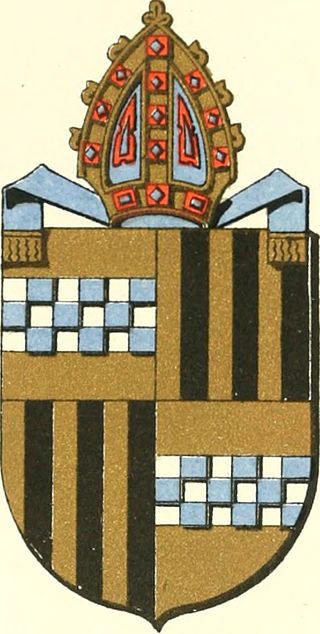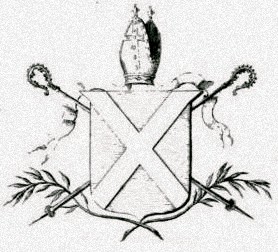Related Research Articles
The Bishop of Dunkeld is the ecclesiastical head of the Diocese of Dunkeld, one of the largest and more important of Scotland's 13 medieval bishoprics, whose first recorded bishop is an early 12th-century cleric named Cormac. However, the first known abbot dates to the 10th century, and it is often assumed that in Scotland in the period before the 12th century, the roles of both bishop and abbot were one and the same. The Bishopric of Dunkeld ceased to exist as a Catholic institution after the Scottish Reformation but continued as a royal institution into the 17th century. The diocese was restored by Pope Leo XIII on 4 March 1878; it is now based in the city of Dundee.
William Turnbull was a Scottish politician and bishop, credited with founding Jedburgh Grammar School and the University of Glasgow. He served as the Bishop of Glasgow, from 1448 to 1454 and was the first Chancellor of the University of Glasgow.

The Lord Chancellor of Scotland, formally the Lord High Chancellor, was a Great Officer of State in the Kingdom of Scotland.

The Bishop of St. Andrews was the ecclesiastical head of the Diocese of St Andrews in the Catholic Church and then, from 14 August 1472, as Archbishop of St Andrews, the Archdiocese of St Andrews.
John Scotus was a 12th-century bishop of St. Andrews and Dunkeld.
Galfredus, Galfred or Geoffrey de Liberatione was Bishop of Dunkeld and Bishop-postulate of St Andrews. He was a clerk to King Alexander II of Scotland as early as 1219, as well as being a canon of Dunkeld and precentor of Glasgow. He was elected to the bishopric of Dunkeld in 1236. After an investigation by Pope Gregory IX regarding a defect of birth possessed by Galfred, he was confirmed as bishop in sometime in 1237.
James Kennedy was a 15th-century Bishop of Dunkeld and Bishop of St. Andrews, who participated in the Council of Florence and was the last man to govern the diocese of St. Andrews purely as bishop. One of the Gaelic clan of Carrick he became an important figure in the government of the minority of King James III of Scotland as well as founder of St Salvator's College, St Andrews.
Walter Trail was a late 14th century Bishop of St. Andrews. He appears as an official in the Bishopric of Glasgow in 1378, as a Magister Artium and a Licentiate in Canon and civil law. In 1380, he has a doctorate in canon and civil law, as well as a Papal chaplain and auditor. In this year, Pope Clement VII granted him the deanery of the Bishopric of Dunkeld. He became treasurer of the Bishopric of Glasgow in either 1381 or 1382. On 29 November 1385, the Pope provided him to the vacant Bishopric of St. Andrews, vacant because of the capture and death of the previous bishop-elect, Stephen de Pa.

Gilbert de Greenlaw (1354–1421) was a medieval Bishop of Aberdeen and Bishop-elect of St. Andrews. He was a Licentiate in the Arts, and had been a canon of Bishopric of Moray by the late 1370s, before being provided by Avignon Pope Clement VII the church of Liston in the Bishopric of St. Andrews in 1379. By the later 1380s, he was in the diocese of Aberdeen. In 1389, he was elected to hold the bishopric of Aberdeen, a position to which he was consecrated in 1390. Gilbert subsequently went on to hold the position of Chancellor of Scotland for many years, albeit in an interrupted manner. Gilbert was subsequently postulated to the more prestigious bishopric of St. Andrews after the death of Walter de Danyelston, its previous Bishop-elect. However, Avignon Pope Benedict XIII quashed the postulation, and chose Henry Wardlaw in his stead. Gilbert, then, remained Bishop of Aberdeen, and died in 1421.
Robert Blackadder was a medieval Scottish cleric, diplomat and politician, who was abbot of Melrose, bishop-elect of Aberdeen and bishop of Glasgow; when the last was elevated to archiepiscopal status in 1492, he became the first ever archbishop of Glasgow. Archbishop Robert Blackadder died on 28 July 1508, while en route to Jerusalem on pilgrimage.
George Brown was a late 15th-century and early 16th-century Scottish churchman. He first appears on record in 1478 as the rector of the church of Tyningham, and is called a clerk of the diocese of Brechin. In 1482, he was selected to be Chancellor of the diocese of Aberdeen.

Andrew Stewart was a 16th-century Scottish noble and cleric. He was a legitimate son of John Stewart, 1st Earl of Atholl and Eleanor Sinclair, daughter of William Sinclair, Earl of Orkney. His paternal grandmother was Joan Beaufort, former queen-consort of Scotland. Andrew chose an ecclesiastical career, held a canonry in Dunkeld Cathedral and was rector of Blair parish church, a church under the control of the earls of Atholl.
John de Carrick, a native of Carrick, Scotland, was a 14th-century Chancellor of Scotland and Bishop-elect of Dunkeld. Although John's exact origins are obscure, he seems to have come from a branch of the old native comital family of Carrick. Later evidence suggests he was a graduate of canon law, but the university is not known.
Thomas de Rossy O. F. M. was a late 14th century Scottish Franciscan friar, papal penitentiary, bishop and theologian. Of unknown, or at least unclear origin, he embarked on a religious career in his early years, entering the Franciscan Order, studying in England and at the University of Paris.
Thomas de Buittle [Butil, Butill, Butyll, Butyl, Bucyl] was a Scottish prelate, clerk and papal auditor active in the late 14th and early 15th centuries. Probably originating in Galloway, Scotland, Thomas took a university career in canon law in England and France, before taking up service at the court of Avignon Pope Benedict XIII. He obtained a number of benefices in the meantime, including the position of Archdeacon of Galloway, and is the earliest known and probably first provost of the collegiate church of Maybole. The height of his career came however when the Pope provided him to the bishopric of Galloway, a position he held from 1415 until his death sometime between 1420 and 1422.
Ninian Spot [de Spot] was a royal clerk and prelate in the 15th century Kingdom of Scotland. He spent much of his youth at university, eventually obtaining Master's Degree.
John Bullock O.S.A. was an Augustinian canon and prelate active in the 15th century Kingdom of Scotland. While earning a university degree between 1409 and 1417, Bullock gained several benefices in Scotland, and claimed the headship of St Andrews Cathedral Priory before becoming Bishop of Ross in 1418. He held the latter position until his death, which occurred in either 1439 or 1440.
Laurence de Ergadia was a thirteenth-century Scottish bishop. Probably from the MacDougall kindred of Argyll, Laurence had become a Dominican friar and presumably university graduate before being elected Bishop of Argyll, an election which took place sometime between 1262 and 1264. Although the election was quashed by the Pope in 1264, the Pope gave him a fresh provision to the bishopric. Laurence appears intermittently in the records during his three and a half decade episcopate, but his activities in his own diocese are badly recorded. He died as Bishop of Argyll sometime in either 1299 or 1300.

The Archdiocese of St Andrews was a territorial episcopal jurisdiction of the Catholic Church in early modern and medieval Scotland. It was the largest, most populous and wealthiest diocese of the medieval Scottish Catholic church, with territory in eastern Scotland stretching from Berwickshire and the Anglo-Scottish border to Aberdeenshire.
References
- Dowden, John, The Bishops of Scotland, ed. J. Maitland Thomson, (Glasgow, 1912)